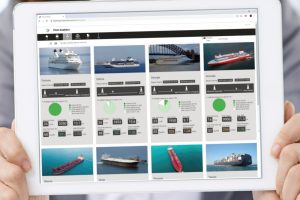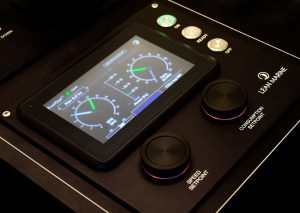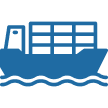Major regulatory changes are coming, when IMO meets in its Marine Environment Protection Committee next month it is expected that confirmation of these changes will challenge the maritime sector like never before. Anders Bergh, Technical Sales Manager at Lean Marine offers a view on how to meet these new demands.
Climate change is an urgent crisis that requires efforts from all stakeholders in the shipping industry. While the International Maritime Organization (IMO) has put a goal-based framework in place to bring down emissions by set deadlines, it is clear that most companies can, and want to, do more than merely comply with the regulatory minimum standards.
This is not to say that IMO’s regulatory efforts fall short. The organisation is likely to confirm the adoption of the Energy Efficiency Existing Ship Index (EEXI) at the 76th meeting of its Marine Environment Protection Committee’s (MEPC) meeting this June. The EEXI, which is likely to enter into force on 1 January 2023, is the evolution of the Energy Efficiency Design Index (EEDI) and is aimed at the existing fleet of vessels which, until now, has not been impacted by EEDI requirement.
This approach to reducing emissions from existing vessels, combined with further clarification on the EEXI and an annual operational Carbon Intensity Indicator (CII), will require the industry to take a more active role in complying with these new requirements.
Given that the vessels that are in operation today will continue to represent a large part of the global fleet until 2050, it is unsurprising that the shipping industry is already seeing companies evaluate their ships for EEXI and CII (which is linked to a rating system for ships of 5,000 gross tonnes and above). The process of compliance will involve many other stakeholders, such as class societies, that can facilitate necessary regulatory compliance.
I believe the take-up by the industry itself, alongside of the overarching regulatory body of the IMO, signals a significant shift in the sector’s aim to achieve a global result. The baseline set by the IMO is invaluable as it sets a point from which to usher in a greener future.
Assessing the global fleet
Change is always challenging, and the majority of the maritime sector is beginning an uphill climb. Class society DNV estimates that approximately 80% of the global trading fleet will have to make technical upgrades to meet the minimum energy efficiency standards within EEXI. Similarly, ABS suggests that almost 7,000 tankers will need to explore their options to reach these requirements, based on the understanding that almost 70% of the current global tanker fleet was likely contracted prior to January 2013 and delivered prior to July 2015 – thus without an EEDI value. Meanwhile, Clarkson’s Research Service estimates that seven out of 10 bulk carriers do not currently comply with the EEXI.
The calculations are probably somewhat similar for the containership sector. A recent market review by Danish Ship Finance estimated that more than 40% of the global container fleet is over 10 years old. It would be reasonable to assume that the owners of these vessels are exploring currently available solutions to enable eventual compliance with EEXI requirements.
However, a factor worth noting is that the CII has not yet seen the same widespread discussion or planned implementation in the sector. Although a number of ship owners and operators are already in the process of re-evaluating their investment priorities, in order to finance the upgrading of their existing fleet to achieve EEXI compliance, we believe that CII compliance will require a different approach.
Diverging paths to compliance
EEXI compliance requires easy to implement technologies with the benefit of immediate emission reductions, creating this as a short-term investment priority and relatively immediate solution. Among the recommended measures currently available are engine power limitation (EPL), shaft power limitations (ShaPoLi), propulsion optimisation, energy-saving devices, and more. Within the EEXI framework, derating engine power output via EPL or ShaPoLi is currently the primary measure under discussion to reduce greenhouse gas (GHG) emissions.

Fleet Analytics, smart performance and management reporting.Meanwhile the CII framework for ships of 5,000gt and above requires continuous action over a longer term. Once the required operational carbon intensity indicator is determined, an annual reduction factor needs to be implemented to ensure the continuous improvement of the operational carbon intensity. As these vessels are already subject to the requirement of a data collection system for fuel oil consumption, we must question whether the current monitoring systems will be able to support the shipowner or operator in complying with this new regulation.
With the benefit of my own experience with propulsion systems and vessel efficiency for more than ten years, there are clear indicators for what should serve as best practice going forward. The key take-away here is that the industry now has a chance not just to reduce emissions to meet requirements, but also to seize the opportunity to further improve vessel efficiency as new technology is being adopted.
Simplifying technological solutions
At the outset, it is crucial to define the needs of each specific vessel in a fleet. Currently the EEXI framework suggests derating engine power output as the primary and most efficient measure, and technologies facilitating ShaPoLi will be at the forefront of this manoeuvre as they are less invasive for existing machinery.
However, for ship operators, power limitation measures immediately raise concerns of operational efficiency as well as emergency power requirements. Any technology that affords compliance must also ensure that operations are not compromised, particularly as this will affect the industry’s will to continue with greener technologies in the long term.
I think it is essential to think beyond the current challenge and assess the wider context for the industry. This can allow us to seek advantages that may seem like a bonus in the current regulatory landscape, but that are their own form of future-proofing.
At Lean Marine, we ensure that we tackle these existing issues and those on the regulatory horizon with the same straightforward solution. Our propulsion automation system FuelOpt enables ShaPoLi application by simply setting an upper limit to shaft power output without any modification to existing machinery. When the system is activated, it dynamically optimises the propulsion machinery in real-time to get the best operational result based on the commands set and varying environmental conditions, while respecting this upper limit as stipulated by EEXI requirements.
Notably, the full power of the engine remains available to be used in an emergency event. By providing a direct interface between the bridge crew and machinery of the vessel, we ensure that they can control the parameters that matter the most for enhanced vessel efficiency: speed, consumption, power, or a combination thereof. This also allows the captain and the crew to avoid potential over-consumption of fuel in harsh conditions.

FuelOpt.We know that simple, straightforward solutions are exactly what the industry needs, and this is integral to our approach. We’ve ensured that our system can be easily installed on any vessel regardless of type, size, age, fuel burned or existing machinery onboard. For example, on vessels with a controllable pitch propeller, FuelOpt acts as a dynamic tuning system for the propulsion machinery and regulates the propeller’s pitch and RPM separately to operate the engine and propeller at optimal conditions. In this way, the system produces the maximum amount of propeller thrust with the minimum amount of power, optimising energy usage, and minimising emissions. This sustainable approach benefits not just the operator, but also the industry (which must display its commitment to the environment) and the wider world itself.
Long term compliance goals
As mentioned before, the CII requires shipping companies to improve on annual operational carbon intensity. This is only possible through a performance management tool that evaluates collected fuel consumption data.
This issue is something we had foreseen. Thus, the FuelOpt system gathers vast volumes of vessel data in real time from signals onboard (such as the GPS, speed log, fuel consumption, shaft power, alarm system, etc.), particularly from the propulsion line and engine, and integrates this into Fleet Analytics – our smart cloud-based performance management and reporting system.
We also offer shipowners and operators the option to integrate with any existing performance tool they use. I believe that a willingness to work with other providers in the market is also critical, as the solutions for decarbonisation must be industry wide. We cannot achieve global change by making available solutions harder to implement.
But we must remember that investing in these solutions is just the first step. Although our performance management tool will identify areas for further improvements, it is up to individual ship operators to implement actions to make these gains–and the path to success may not always be obvious.
However, for those that work towards long-term goals, the successful execution of these improvements is at the heart of CII compliance, and will be the key to lowering emissions over time.

Anders Bergh – Technical Sales Manager at Lean Marine
Anders Bergh is the Technical Sales Manager at Lean Marine, currently focused on implementing new products and technologies from Lean Marine’s portfolio. Having graduated with a degree in engineering physics in 2008, he’s spent all of his professional career in the maritime industry. His previous roles have included sales management and product development for engine and propulsion companies.
 Hotline: 0944 284 082
Hotline: 0944 284 082
 Email:
Email: 


 VN
VN